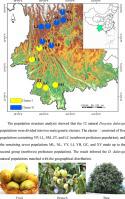Journal of Applied Research on Medicinal and Aromatic Plants ( IF 3.9 ) Pub Date : 2021-02-02 , DOI: 10.1016/j.jarmap.2021.100294 Jingyu Peng , Chen Shi , Dawei Wang , Shuangzhi Li , Xueli Zhao , Anan Duan , Nianhui Cai , Chengzhong He

|
Docynia delavayi is a wild fruit tree with high medicinal value that grows in southwest China. The exploitation and utilization of D. delavayi as a wild resource is constrained by a relative lack of genetic information. In the present study, 18 transcriptome-based simple sequence repeat (SSR) markers were developed using RNA-seq technology. Based on the SSR data, the D. delavayi populations showed high genetic diversity with mean observed heterozygosity (Ho), expected heterozygosity (He), Shannon’s Information Index (I) and polymorphism information content (PIC) values of 0.697, 0.522 0.884, and 0.587, respectively. Lower gene flow (Nm = 1.461) and higher genetic differentiation (Fst = 0.180) were detected among the populations. The results of clustered heatmap, Structure, and PCoA analyses showed that the 12 populations were divided into two clusters (Southwest and Northwest Prefecture populations), which was consistent with the Mantel test revealing a positive correlation between geographic and genetic distance (r = 0.342, p < 0.01). Overall, the genetic diversity of the D. delavayi natural populations was successfully investigated based on SSR markers. This study will provide a theoretical basis for conservation management, genetic improvement, and construction of the core germplasm.



























 京公网安备 11010802027423号
京公网安备 11010802027423号